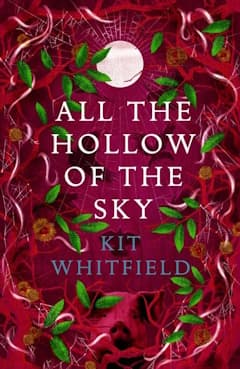
All the Hollow of the Sky by Kit Whitfield
(Jo Fletcher Books, 2023)
Reviewed by Anne F. Wilson
All the Hollow of the Sky is a sequel to Whitfield’s previous novel, In the Heart of Hidden Things. This introduced us to the three generations of Smiths who live in the village of Gyrford: Jedediah the farrier, Matthew his son and John his ten-year-old grandson, an intelligent lad who never knows when to keep his mouth shut. I don’t think you need to read the first book in order to enjoy the second, but it is delightful and why wouldn’t you?
The novels are set sometime between the medieval period and the early eighteenth century, before steam power. The location is unspecified, but Kidderminster is a nearby town. The struggles of the villagers do not relate to the outside world, however, but to their relations with the Fey, or the “Kind Friends” who cause more upsets when they try to help the humans than when they don’t.
The Smiths are fairy-smiths, and their role is to deal with the Fey, with cold iron and their wits. You might have thought the church would be involved here, but although there is a church, and villagers are christened, married and buried, that seems to be the limit of its role.
The sequel is set a couple of years after the first book and introduces us to the Smiths’ wider family: Jedediah’s grandfather, Clem (now deceased); Clem’s five daughters; and his lecherous and bullying son-in-law Corbie, Jedediah’s father. Clem tried to do the right thing by a fey called Ab, and he and his daughters were showered with unwelcome gifts thereafter. Corbie decided to deal with Ab with cold iron, and shut it up in a hollow tree. But on Jedediah’s wedding day, to his family’s great relief, Corbie vanished.
Forty years later, the Ab-tree is broken, Ab returns, and this time he’s angry. Coincidentally, Corbie returns as well, irritatingly wandering in his wits, but no older than when he disappeared, and no less abusive.
The story’s very involved, hopping about in time between the present and past and featuring engaging non-human characters such as a talking pig with green spines, stone wolves, and a cowardly giant spider. The first time I read it there was so much going on that I failed to follow the plot in detail, but was gripped by the sheer entertainment of finding out what would happen next.
Whitfield certainly knows how to ratchet up the tension. She creates believable characters that the reader cares about and then puts them through hell. She’s also good at showing how people can fail to communicate effectively when their maps of the world are radically different.
The author comes from a neuro-diverse family, and this is reflected in young John’s absolute focus on whatever is occupying his attention. There are also the enchanted aunts. The author says in her blog: “The thing is, neurodivergence and feyness have a long history together. Contemporary ND people often relate to the myth of the changeling…Fairies…have rules of their own, which they hold to implacably, but which a normal person may not understand at all—until they cross them.”
The novel contrasts two ways of dealing with the Fey, Corbie’s brute force and cold iron, and young John’s attempts to understand and negotiate with them.
I thoroughly enjoyed the book. Whitfield delineates character and relationships with great delicacy, and joyfulness in invention. I completely believed her descriptions of how the village operates, from the feasts and celebrations to the hungry times of winter. There are always errands to run and neighbours to support. Also, everybody knows everybody else’s business.
If there’s a moral to draw from the novel, it could be summarised as: There are rarely simple solutions to complex problems. Sometimes you need to be capable of seeing the issue from every angle, particularly from the viewpoint of those who seem to be causing the problem.
Review from BSFA Review 21 - Download your copy here.
